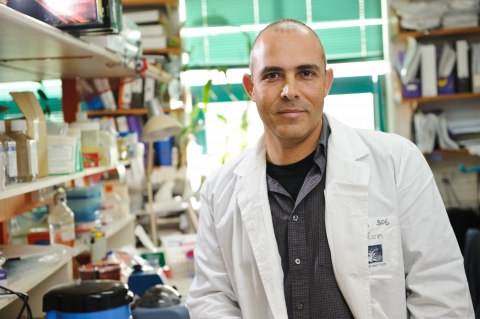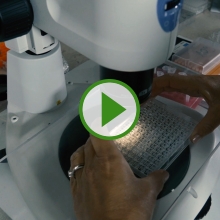The new science of sad
Lifting the shroud of mystery on depression
Features

From investigations of the immune system to explorations of proteins in the brain, Weizmann Institute scientists are making major strides in understanding the biochemistry of depression and severe anxiety.
It’s a topic that has vast implications for human health. The World Health Organization estimates that 10 percent of the world population suffers from depression, anxiety, and related disorders. Anti-depressants available provide only a partial solution, and nearly two-thirds of patients report getting no relief from existing medications.
In a recent discovery, Prof. Alon Chen in the Department of Neurobiology identified a tiny molecule in the brain that controls levels of serotonin, a key neurotransmitter closely involved in depression. The insight could help lead to better diagnosing—and potentially treating—depression. This spring, the Institute’s technology transfer arm, Yeda, licensed rights to miCure Therapeutics, based in Nes Ziona, to develop a drug and diagnostic method.
Scientists understand that stress is a major trigger for depression. In recent years, Prof. Chen’s research group has focused on the role of microRNAs (miRNAs) inthe regulation of the stress response. MicroRNAs are small, non-coding RNAs that often “fine tune” which products of genes are expressed and which are silenced after they are transcribed by RNA.
He and his colleagues searched for microRNA molecules involved in the nerve cells that produce serotonin. They identified, for the first time, a miRNA that acts on the serotonin-producing nerve cells. They found a connection between a particular microRNA - miR135 - and two proteins that play a key role in serotonin production regulation.
They then genetically engineered mice to produce higher-than-average amounts of miR135. These mice did not develop the behaviors associated with chronic stress, such as anxiety or depression, which would normally appear. In contrast, mice that expressed low levels of miR135 exhibited more of these behaviors and responded weakly to antidepressants. “Our conclusion is that the brain needs the proper miR135 levels to remain healthy,” Prof. Chen says.
The researchers then found that human subjects who suffered from depression had unusually low miR135 levels in their blood, and on closer inspection, the scientists found a connection between miR135 and genes linked to bipolar and mood disorders. These findings, published in the journal Neuron, suggest that miR135 could be a useful therapeutic molecule - both as a blood test for depression and related disorders - and as a target for a new type of antidepressant.
The role of immunity
Meanwhile, a strong immune system can protect against depression, according to mounting scientific evidence. Prof. Michal Schwartz in the Department of Neurobiology has been changing the common thinking about immunology and the brain. Researchers once thought the brain was isolated behind the blood-brain-barrier, and that this protected it from immune cells, which were conceived as threats to the brain. Prof. Schwartz has been gathering convincing evidence that healthy brain maintenance depends on the immune system, which helps it adapt to a constantly changing environment. The state of the immune system, she has found, also dictates how we will adapt to stressors we encounter.
More than a decade ago, Prof. Schwartz and her research group showed that immune cells that circulate in the blood, called T cells, are involved in the repair of the central nervous system following an acute injury. Since then, Prof. Schwartz found that these circulating immune cells could protect the neurons in the brain from various neurodegenerative diseases and imbalances in neurotransmitter levels in depression.
They recently showed that T cells are sent to the brain in greater numbers following acute stress. Indeed, mice with enhanced T cell levels exhibited an improved ability to cope with stress. When exposed to serious stress, the levels of one of the brain’s proteins , called BDNF, is impaired in the hippocampus, but can be restored to pre-stress levels with the assistance of the immune system. This team wondered, “Could boosting the immune response ameliorate the suppression of these levels imposed in the brain by stress?” They showed that mice inoculated with a central nervous system peptide before their exposure to a stressful predator odor showed reduced anxiety levels as well as enhanced recovery of BDNF in the brain’s hippocampus region.
”There is a life-long dialogue between circulating immune cells and the brain,” Prof. Schwartz says. She suggests that it might be possible to design a safe vaccine that would increase resilience to psychological stress, without any side-effect.
Lighting the way
A challenge for brain research has always been the simple fact that it is difficult to disentangle the complex networks that together make up the brain. The new field of optogentics is changing all that, and may have implications for depression. In optogenetics, scientists can make genetic alterations in specific brain cells that enable the cells to sense and respond to light. Dr. Ofer Yizhar, also in the Department of Neurobiology, is one of the pioneers in developing new optogenetic tools and techniques, and is recording the activity of individual neurons in the prefrontal cortex. Recent clinical work has shown that stimulating this region can lead to dramatic recovery in severely depressed patients that have ceased to respond to typical antidepressants. Although much work is still needed to figure out which cells and circuits are most strongly affected by this therapy, research suggests that optogenetic tools can assist in pinpointing the relevant circuits.
In the same department, Dr. Yaniv Ziv has devised ways to use miniature cameras, microscopes, optical fibers, and optogenetic agents to film large numbers of neurons deep inside living brains to study the dynamics underlying long-term memory. “If we can understand the underlying problems in information processing, there might be an opportunity to design new therapeutics that will target a specific circuit or an aspect of its function in a way that will restore ‘normal’ function,” Dr. Ziv says.
Prof. Gil Levkowitz and his group in the Department of Molecular Cell Biology are using these new tools to define the formation of the hypothalamus—a brain region which regulates fundamental body functions including metabolism, emotional stress, and social behavior, and has major involvement in depression. “It seems that the optically transparent zebrafish has naturally evolved as the ultimate model organism for the application of light-activated optogenetic tools,” says Prof. Levkowitz. Using such techniques, he and his lab are mapping developing nerve circuits throughout the brain development process, and tracing related genetic factors that affect physiological and behavioral functions.
He recently figured out how nerve cells in the brain’s hypothalamus region communicate with blood vessels in what is in essence an endocrine bridge between the brain and the bloodstream. Via this bridge, hormones of the hypothalamus control physiological functions throughout the body.
Prof. Chen is supported by the Henry Chanoch Krenter Institute for Biomedical Imaging and Genomics, the Perlman Family Foundation founded by Louis L. and Anita M. Perlman, the Adelis Foundation, the Irving I Moskowitz Foundation, and the European Research Council. He runs the Ruhman Family Laboratory for Research in the Neurobiology of Stress.
http://www.weizmann.ac.il/neurobiology/labs/chen
Prof. Levkowitz is supported by the Henry Chanoch Krenter Institute for Biomedical Imaging and Genomics, the Kirk Center for Childhood Cancer and Immunological Disorders, the Irwin Green Alzheimer's Research Fund, and the estate of Lore Lennon. He is the incumbent of the Elias Sourasky Professorial Chair.
http://www.weizmann.ac.il/mcb/GLevkowitz
Prof. Schwartz is supported by the Jeanne and Joseph Nissim Foundation for Life Sciences Research, the Adelis Foundation, the European Research Council, Nathan and Dora Oks of France, and Hilda Namm of Larkspur, CA. She is the incumbent of the Maurice and Ilse Katz Professorial Chair of Neuroimmunology.
http://www.weizmann.ac.il/neurobiology/labs/schwartz
Dr. Yizhar is supported by the Henry Chanoch Krenter Institute for Biomedical Imaging and Genomics, the Clore Center for Biological Physics, the Adelis Foundation, the Carolito Stiftung, the Iby and Aladar Fleischman Foundation, the Candice Appleton Family Trust, the Minna-James-Heineman Stiftung, the Irving B. Harris Fund for New Directions in Brain Research, the Joseph D. Shane Fund for Neurosciences, the Corinne S. Koshland Equipment Endowment Fund, the European Research Council, and the Irving Bieber, M.D. and Toby Bieber, M.D. Memorial Research Fund. He is the incumbent of the Gertrude and Philip Nollman Career Development Chair.
http://www.weizmann.ac.il/neurobiology/labs/yizhar
Dr. Yaniv Ziv is supported by the Irving I Moskowitz Foundation.

Prof. Alon Chen








